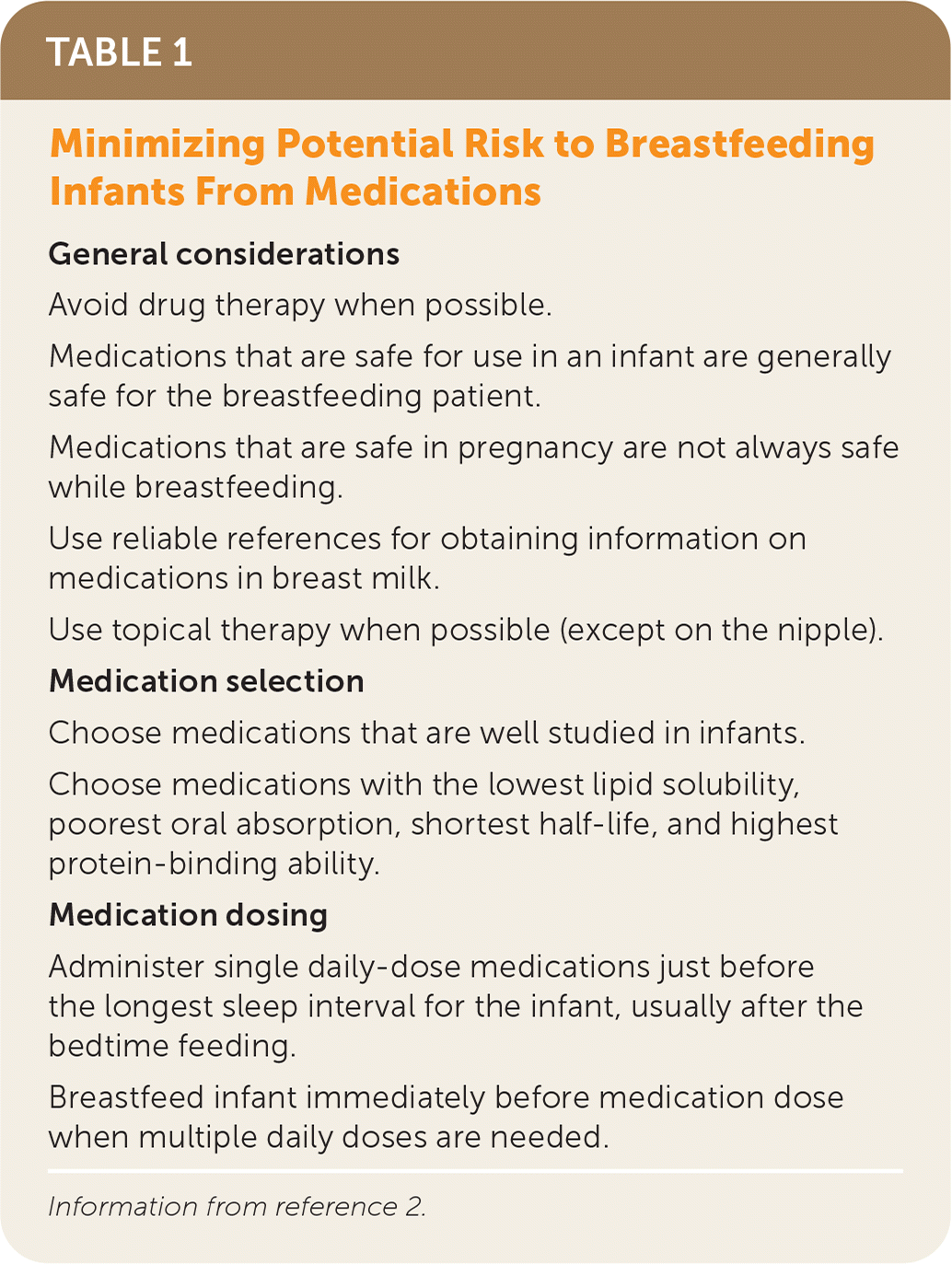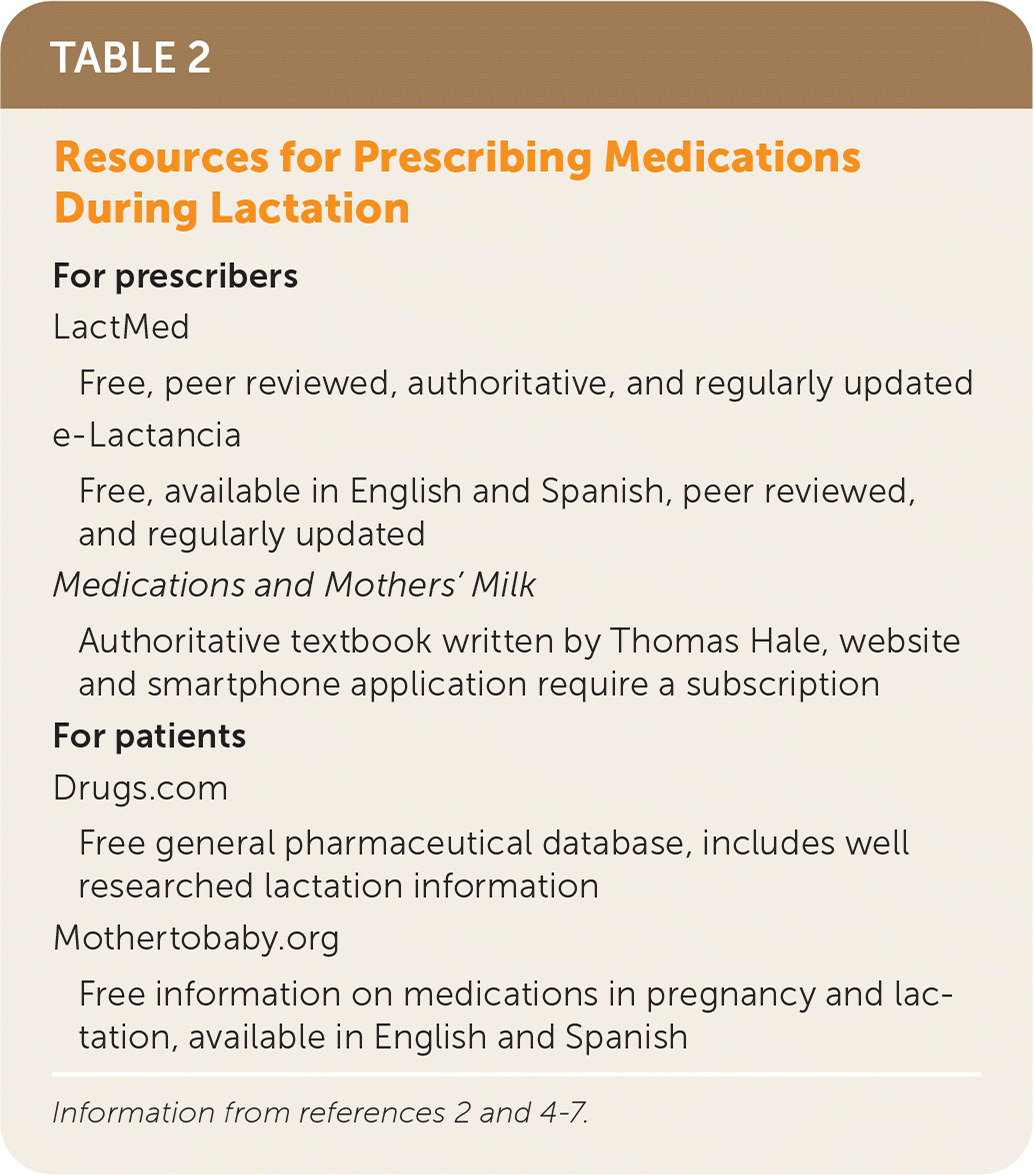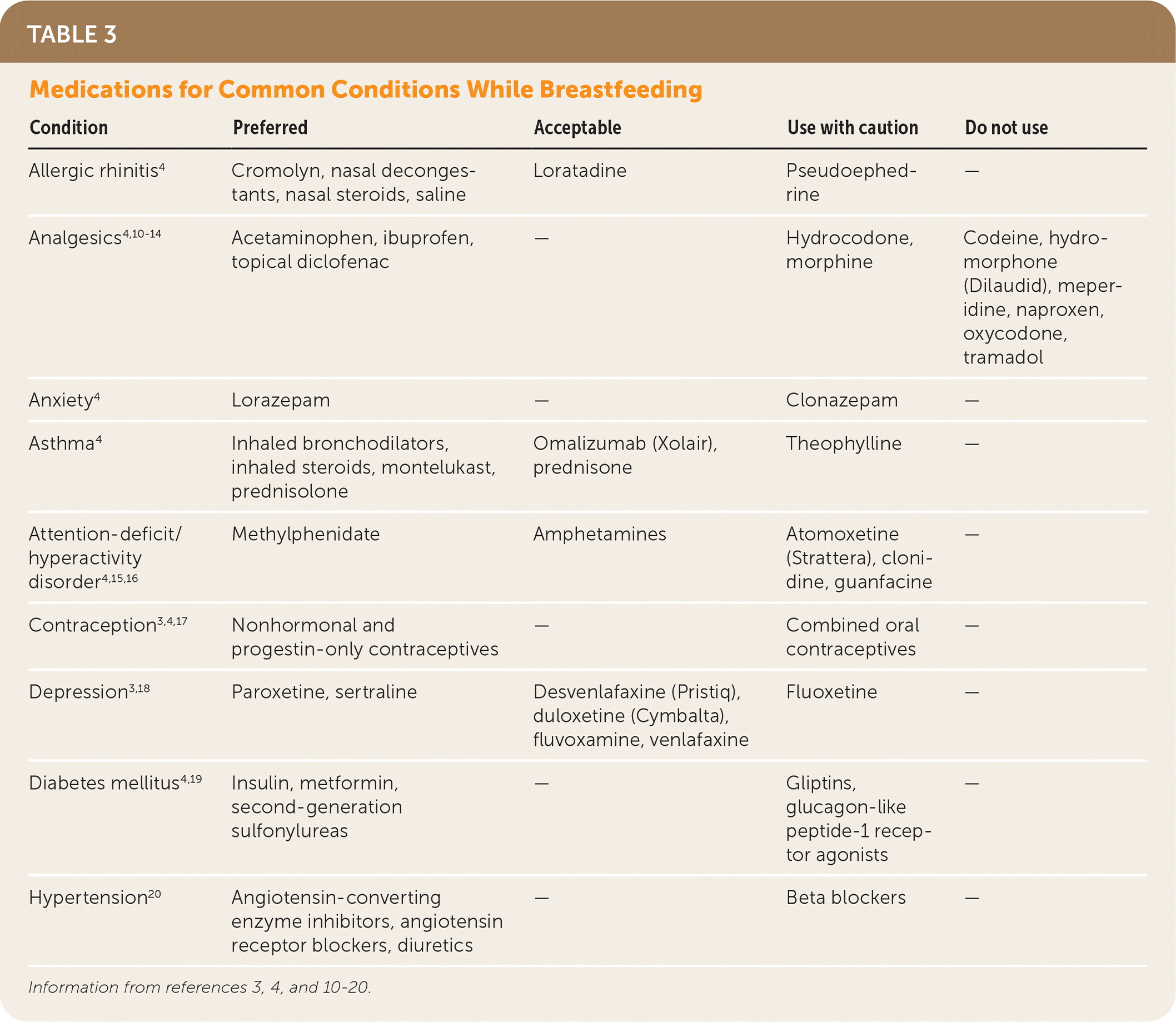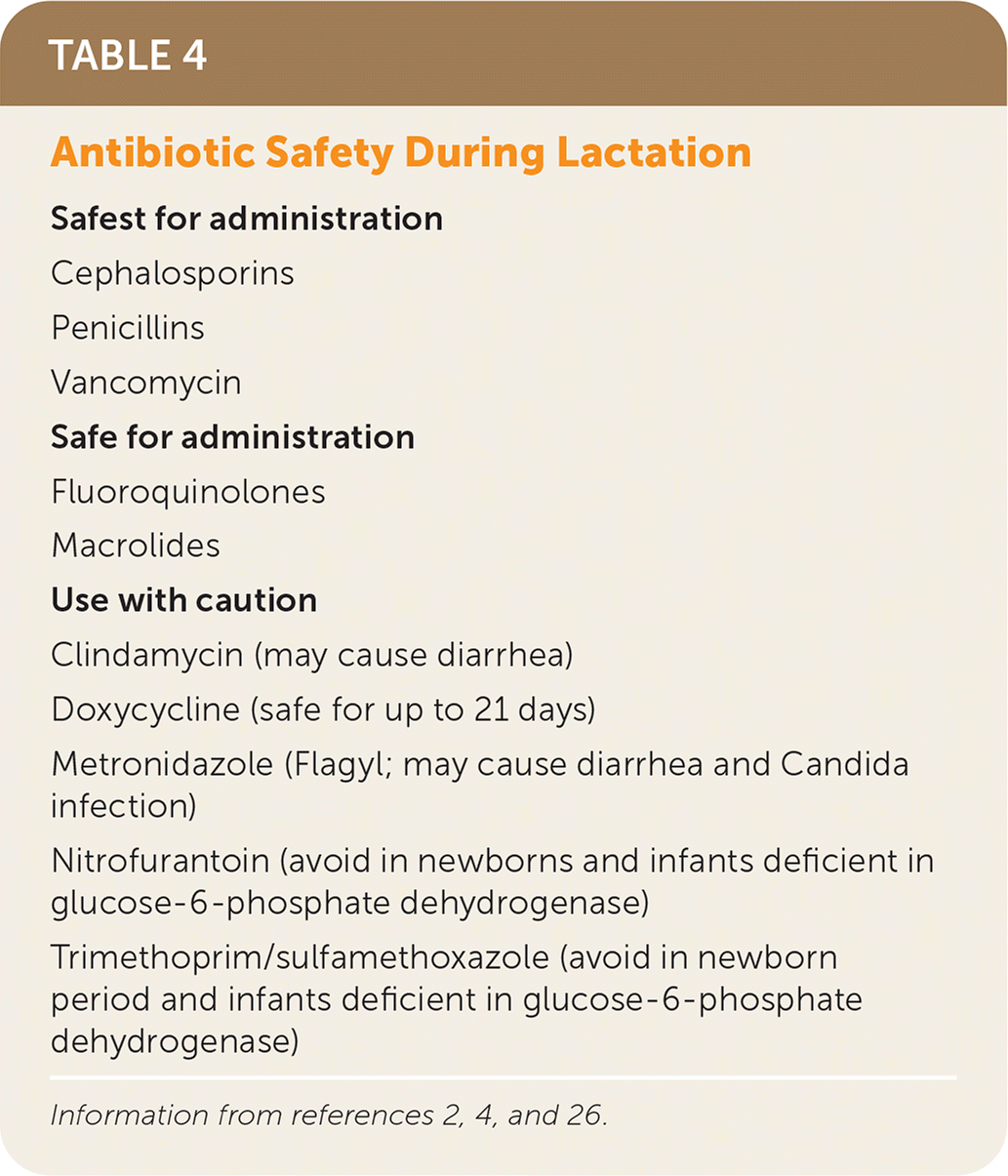
Am Fam Physician. 2022;106(6):638-644
Author disclosure: No relevant financial relationships.
Breastfeeding is universally recognized as the preferred method of infant nutrition, but is sometimes abbreviated because of fear of harm to the infant from maternal medication. The amount of medication that enters breast milk varies based on the maternal serum concentration and the pharmacologic properties of the medication. When prescribing medications for a breastfeeding patient, those with the lowest risk to the infant should be selected, and dosing should be before the infant’s longest sleep interval. Prescribers should use current, accurate resources. LactMed is a convenient, government-sponsored, authoritative resource that lists safety information for many medications and is available free online. When mental health conditions occur during lactation, priority should be given to effectively treating the mother, often with medications that were effective during pregnancy. Most antidepressants are compatible with breastfeeding. Stimulant medications may decrease milk supply. Insulin, metformin, and second-generation sulfonylureas are generally preferred to treat diabetes mellitus during breastfeeding, but newer agents require caution because they have not been studied in lactation. Inhaled and nasal treatments for asthma and allergic rhinitis are unlikely to affect breastfed infants. Acetaminophen and ibuprofen are preferred analgesics during lactation. Maternal opioid use can cause infant sedation. Herbal supplements are concerning for risk of impurities and lack of study of effects on breastfed infants. Nonhormonal and progestin-only contraceptives are preferred over combination oral contraceptives. Contrast for computed tomography or magnetic resonance imaging is not concerning during lactation, but use of radiopharmaceuticals, such as iodine 131, can accumulate in the lactating breast and increase risk to the infant.
Breastfeeding is universally recognized as the preferred method of infant feeding and is associated with decreased infant mortality, but it is sometimes abbreviated because of fear of harm to the infant from maternal medication.1 Despite this, physicians often receive little education on supporting breastfeeding. Comprehensive assessment can prevent unnecessary avoidance of breastfeeding, premature discontinuation of breastfeeding, or suboptimal treatment of the mother’s condition. This article provides information on the management of medications for common conditions during lactation.
| Clinical recommendation | Evidence rating | Comment |
|---|---|---|
| Selective serotonin reuptake inhibitors are generally safe to use during breastfeeding; fluoxetine should be avoided if possible.3,18,21 | B | Systematic review |
| Insulin, metformin, and second-generation sulfonylureas are preferred during breastfeeding because newer agents are not well studied.4,19 | C | Expert consensus |
| Nasal steroids are the preferred treatment for allergic rhinitis during breastfeeding.4 | C | Expert consensus |
| Progestin-only contraceptives are preferred to combination oral contraceptives during breastfeeding.4 | C | Expert consensus |
| Breastfeeding should be stopped if the administration of radioactive iodine 131 is required.31 | C | Disease-oriented evidence |
Transfer of Medications Into Breast Milk
Medications enter breast milk through diffusion from serum, so milk concentrations depend on maternal serum drug concentrations and diffusion characteristics. Few medications are actively transported into breast milk.2,3 Medications generally diffuse out of breast milk as the concentration in maternal plasma diminishes. Unlike the placental transport in pregnancy, medication absorption in breastfeeding is via the infant gastrointestinal tract.
The amount of medication that enters the infant through breast milk is determined by the medication concentration in the milk, volume consumed, and gastrointestinal absorption.2,3 In the early postpartum period, large gaps between mammary alveolar cells allow medication to enter the milk more readily. This effect is mitigated by the small volume of colostrum consumed. Topical medications are generally safer than oral medications, although medications applied to the nipple may be concerning. The infant’s health can alter the effect of exposure to maternal medication. A smaller exposure may be significant in an infant with less ability to metabolize medications. The same medication exposure may be less problematic in an older, healthy infant who is nearly weaned.2,3

| General considerations |
| Avoid drug therapy when possible. |
| Medications that are safe for use in an infant are generally safe for the breastfeeding patient. |
| Medications that are safe in pregnancy are not always safe while breastfeeding. |
| Use reliable references for obtaining information on medications in breast milk. |
| Use topical therapy when possible (except on the nipple). |
| Medication selection |
| Choose medications that are well studied in infants. |
| Choose medications with the lowest lipid solubility, poorest oral absorption, shortest half-life, and highest protein-binding ability. |
| Medication dosing |
| Administer single daily-dose medications just before the longest sleep interval for the infant, usually after the bedtime feeding. |
| Breastfeed infant immediately before medication dose when multiple daily doses are needed. |
Breastfeeding Resources
Although pharmacologic knowledge can be helpful when prescribing medications for breastfeeding patients, use of up-to-date, accurate resources is essential. Table 2 lists resources for prescribing medications during lactation.2,4–7 The LactMed database is produced by the National Library of Medicine.4 It is a comprehensive, authoritative resource that is peer reviewed, continuously updated, and available free online.

| For prescribers |
| LactMed |
| Free, peer reviewed, authoritative, and regularly updated e-Lactancia |
| Free, available in English and Spanish, peer reviewed, and regularly updated |
| Medications and Mothers’ Milk |
| Authoritative textbook written by Thomas Hale, website and smartphone application require a subscription |
| For patients |
| Drugs.com |
| Free general pharmaceutical database, includes well researched lactation information |
| Mothertobaby.org |
| Free information on medications in pregnancy and lactation, available in English and Spanish |
Several nongovernment resources are available. e-Lactancia originated in Spain and provides information in English and Spanish. It is produced by a nonprofit organization and includes similar information to LactMed but in a more user-friendly format.5 Thomas Hale’s Medications and Mothers’ Milk is a proprietary comprehensive resource available online, through a smartphone application, and as a textbook.2 Drugs.com publishes patient information on medications in lactation and is regularly updated.6 MotherToBaby.org publishes patient-centered fact sheets on the use of many medications during lactation.7
The 2014 update of the pregnancy and lactation labeling rule from the U.S. Food and Drug Administration requires clearer labeling in package inserts about medication use during pregnancy and lactation; however, not all labeling has been updated.8,9 A recent review of various resources for medication use during lactation found large variations, with package inserts being more restrictive and LactMed being the least restrictive.9
Specific Conditions

| Condition | Preferred | Acceptable | Use with caution | Do not use |
|---|---|---|---|---|
| Allergic rhinitis4 | Cromolyn, nasal decongestants, nasal steroids, saline | Loratadine | Pseudoephedrine | — |
| Analgesics4,10–14 | Acetaminophen, ibuprofen, topical diclofenac | — | Hydrocodone, morphine | Codeine, hydromorphone (Dilaudid), meperidine, naproxen, oxycodone, tramadol |
| Anxiety 4 | Lorazepam | — | Clonazepam | — |
| Asthma4 | Inhaled bronchodilators, inhaled steroids, montelukast, prednisolone | Omalizumab (Xolair), prednisone | Theophylline | — |
| Attention-deficit/hyperactivity disorder 4,15,16 | Methylphenidate | Amphetamines | Atomoxetine (Strattera), clonidine, guanfacine | — |
| Contraception3,4,17 | Nonhormonal and progestin-only contraceptives | — | Combined oral contraceptives | — |
| Depression3,18 | Paroxetine, sertraline | Desvenlafaxine (Pristiq), duloxetine (Cymbalta), fluvoxamine, venlafaxine | Fluoxetine | — |
| Diabetes mellitus4,19 | Insulin, metformin, second-generation sulfonylureas | — | Gliptins, glucagon-like peptide-1 receptor agonists | — |
| Hypertension20 | Angiotensin-converting enzyme inhibitors, angiotensin receptor blockers, diuretics | — | Beta blockers | — |
BEHAVIORAL HEALTH
Behavioral health concerns are common during pregnancy and lactation. Effectively treating the mother is the highest priority because this allows for the most effective parenting and bonding.
Depression. The preferred approach for treating depression during lactation is to continue any treatment that was effective during pregnancy. Selective serotonin reuptake inhibitors are generally safe during breastfeeding. The most preferred are sertraline, and paroxetine (generally not used in pregnancy because of teratogenicity in first trimester) because these are the best studied, and they have low infant exposure and fewer adverse effects.3,18,21 Fluoxetine and its active metabolite have a long half-life and should be avoided if possible. If fluoxetine is effective for a particular patient, observe the infant for irritability.3 Serotonin-norepinephrine reuptake inhibitors are less preferred because of limited data but are generally compatible with breastfeeding.3,18
Anxiety. Antidepressant medications are commonly used to treat anxiety, but acute anxiety may be treated with benzodiazepines. Benzodiazepine use may rarely result in sedation of the breastfeeding infant, which must be weighed against the benefit of treating maternal anxiety. In one small study, sedation of benzodiazepine-exposed infants was rare and associated with taking other psychoactive medications such as opiates, antipsychotics, or antidepressants.22 With its short half-life, lorazepam is a safer benzodiazepine during lactation.4 Clonazepam is more likely to cause infant sedation because it may accumulate in the infant because of its long half-life.4
Attention-Deficit/Hyperactivity Disorder. Although data for attention-deficit/hyperactivity disorder medications in breastfeeding are limited, methylphenidate appears to be the safest option if medical treatment is necessary. Methylphenidate is found in low levels in breast milk but not in infant serum. It is associated with decreased prolactin levels and raises concern for decreased milk supply, although this has not been reported in breastfeeding patients.4 Amphetamines may decrease serum prolactin and are found in higher levels in breast milk and infant serum.15,16 Clonidine should be used with caution because it passes readily into breast milk.4 Atomoxetine (Strattera) is not well studied, and safer alternatives are preferred.4
Opioid Replacement Therapy. The benefits of breastfeeding while on opioid replacement therapy, including methadone and buprenorphine, outweigh the risks, especially during the current opioid epidemic. Potential adverse effects of opioid replacement therapy on breastfed infants include lethargy, respiratory difficulty, and poor weight gain. Transfer of medications for opioid replacement therapy to the infant through breastfeeding is insufficient to prevent neonatal abstinence syndrome after opioid use during pregnancy, but opioid replacement therapy received through breastfeeding reduces the severity and duration.10 Initiating methadone postpartum or increasing the dosage to more than 100 mg daily while breastfeeding poses a risk of sedation and respiratory depression in the breastfed infant, especially if the infant was not exposed in utero.4
If opioids are taken while breastfeeding, symptoms of withdrawal can occur in the infant after abrupt discontinuation of breastfeeding that would be less likely with slower weaning.4 Methadone exposure may be associated with motor delays during the first year of life; however, research is limited.10,23 The long-term effects of buprenorphine on infants are unknown.4
Marijuana and Cannabinoids. Evidence regarding the effects of tetrahydrocannabinol in breast milk on infant development is limited and conflicting. Tetrahydrocannabinol is concentrated in breast milk, and breastfeeding infants have detectable levels.10 The use of marijuana can impair the ability to care for an infant effectively and safely. In many jurisdictions, marijuana use is reportable to child protective services.24 If marijuana use is continued, limiting the amount and avoiding direct inhalation by the infant are recommended. Some cannabinoid products, including those labeled as cannabidiol only, contain other contaminants such as microbes, pesticides, and heavy metals that could be harmful to the patient and the breastfeeding infant.25
DIABETES MELLITUS
Insulin, metformin, and second-generation sulfonylureas are not found in breast milk and are preferred when breastfeeding. Newer diabetes medications, including glucagon-like peptide-1 (GLP-1) receptor agonists and sodium-glucose cotransporter-2 (SGLT-2) inhibitors, have not been studied in lactation. These agents are large peptide molecules; therefore, the amount entering breast milk is presumably low and gastrointestinal absorption is unlikely.4,19 Manufacturers of SGLT-2 inhibitors do not recommend their use during breastfeeding because of the theoretical risk of injury to the infant’s developing kidneys.4 Medication labels recommend against the use of SGLT-2 inhibitors and GLP-1 receptor agonists during lactation. Labeling inserts suggest that the dipeptidyl-peptidase-4 inhibitors may be used with caution, although there is no documented use of these agents during breastfeeding.4,19
HYPERTENSION
Medications for hypertension are generally acceptable to use during lactation. Calcium channel blockers pass poorly into breast milk.20 Diuretics used at the doses recommended for hypertension do not affect breast milk production and do not pass into the milk.20 Angiotensin-converting enzyme inhibitors do not pass significantly into breast milk. Angiotensin-receptor blockers are highly protein bound and are not expected to enter breast milk, but information is lacking regarding their use during lactation. Pending further study, they should generally be avoided in neonates and preterm infants.20 Excretion of beta blockers into breast milk can vary from drug to drug, and they are not typically first-line treatments for hypertension. Labetalol and metoprolol appear to be minimally excreted and well tolerated, but caution is advised when breastfeeding preterm infants.20
UPPER RESPIRATORY SYMPTOMS
Topical treatments are the safest during lactation for upper respiratory symptoms. Nasal steroids such as fluticasone (Flonase) or budesonide are the safest and most effective treatments for allergic rhinitis while breastfeeding, because topical administration minimizes systemic absorption and infant exposure.4 Nasal saline, antihistamines, and cromolyn are safe but may be less effective. Topical decongestants such as oxymetazoline are preferred to systemic decongestants because they are less likely to affect milk supply or be absorbed by the infant.4 Pseudoephedrine should be used only when there is a well-established milk supply because it may impair milk production.4 Second-generation anti-histamines such as loratadine are less sedating and unlikely to harm the breastfed infant because of low absorption, but they may decrease milk supply.4 First-generation antihistamines are less favored because they cause greater reduction in milk supply and maternal and infant sedation.
ASTHMA
Management of asthma is not significantly changed during breastfeeding. Absorption of inhaled steroids is unlikely to affect breastfed infants.4
Despite limited study, inhaled bronchodilator use is acceptable during breastfeeding because of low bioavailability and maternal serum medication levels after use.4 During exacerbations, oral or intravenous steroids may be used. The amount of prednisone in breast milk is very low and no adverse effects have been reported in breastfed infants.4 If the patient is taking high doses of steroids or has prolonged steroid use, breastfeeding should be delayed for four hours after a dose to decrease infant exposure. High doses of any steroid may decrease milk supply or delay lactation.4
ANALGESICS
Ibuprofen and acetaminophen are the preferred agents for pain control during lactation because of their safety when prescribed to infants and low concentration in breast milk.4 Long-term use of naproxen is discouraged because of its long half-life and reports of bleeding, anemia, and emesis in breastfed infants.4,11 Etodolac, meloxicam (Mobic), piroxicam, and sulindac are not recommended in breastfeeding because of limited data.11 Topical and local anesthetics may be used safely in breastfeeding.12
If an oral opioid is required for pain control, hydrocodone or morphine is preferred. When possible, patients should breastfeed their infants before taking opioids. Low doses should be used for short durations, and they should be avoided while using other sedating medications. The recommended daily dosage of hydrocodone is 30 mg or less.10 Because of its longer half-life, hydromorphone (Dilaudid) should be avoided.12 Oxycodone should be avoided during breastfeeding because of central nervous system depression in 20% of exposed infants.13 The U.S. Food and Drug Administration recommends avoiding codeine and tramadol during breastfeeding because patients who are ultra-rapid metabolizers risk exposing infants to excessively high amounts of active metabolites, sedation, and respiratory depression.10,14 Meperidine should be avoided during breastfeeding because of its long-acting metabolite that is more sedating in infants than adults.4
ANTIBIOTICS
Many commonly prescribed antibiotics are compatible with breastfeeding (Table 4).2,4,26 There may be a risk of the infant experiencing an allergic reaction to the antibiotic or developing diarrhea because of changes in enteric flora. Hematochezia in infants exposed to intravenous clindamycin in breast milk has been reported.4 Because of the risk of bilirubin displacement and kernicterus, trimethoprim/sulfamethoxazole should be avoided in jaundiced, ill, stressed, or premature infants.4 Trimethoprim/sulfamethoxazole and nitrofurantoin should not be used while breastfeeding during the first month of life or in infants with glucose-6-phosphate dehydrogenase deficiency to prevent the risk of hemolysis.4 Cephalosporins are a safer alternative. Candida infections and diarrhea may be more common in infants exposed to metronidazole (Flagyl).4 The calcium in breast milk decreases the oral absorption of fluoroquinolones and doxycycline. Antibiotics may alter the taste of breast milk and cause the infant to decrease intake.2

| Safest for administration |
| Cephalosporins |
| Penicillins |
| Vancomycin |
| Safe for administration |
| Fluoroquinolones |
| Macrolides |
| Use with caution |
| Clindamycin (may cause diarrhea) |
| Doxycycline (safe for up to 21 days) |
| Metronidazole (Flagyl; may cause diarrhea and Candida infection) |
| Nitrofurantoin (avoid in newborns and infants deficient in glucose-6-phosphate dehydrogenase) |
| Trimethoprim/sulfamethoxazole (avoid in newborn period and infants deficient in glucose-6-phosphate dehydrogenase) |
HERBAL SUPPLEMENTS
Herbal products, particularly galactagogues, are frequently used to increase milk production. Common galactagogues, including fenugreek, fennel, and milk thistle, have limited evidence for effectiveness in increasing milk production but have a low risk of toxicity.27 Because herbal products are not subject to the same standards of content verification, manufacturing purity, or effectiveness as medications approved by the U.S. Food and Drug Administration, reliable information on the safety of many herbal products during breastfeeding is lacking.6,28 Information on some agents can be found in LactMed or e-Lactancia.4,5 Kava and yohimbine have been shown to be harmful to infants exposed through breast milk.11 Sage, peppermint, parsley, chasteberry, and jasmine are herbs that appear to decrease milk production.27
CONTRACEPTIVE AGENTS
Nonhormonal contraceptive methods such as barrier methods or a copper intrauterine device (Paragard) are preferred during lactation, especially for the first four to six weeks postpartum. When an intrauterine device is inserted immediately postpartum, the risk of expulsion is likely higher in breastfeeding patients.29 The estrogen in oral contraceptives does not affect the composition of breast milk or infant growth and development but may decrease milk production.4 Progestin-only contraceptives, including the levonorgestrel-releasing intrauterine system, 52 mg, and etonogestrel subdermal contraceptive implant (Nexplanon), are the hormonal contraceptives of choice during breastfeeding to avoid potential complications of thrombosis and decreased milk supply from estrogen exposure. Acceptable timing of postpartum initiation of hormonal contraception is controversial. Combination oral contraceptives should be avoided for three or more weeks postpartum because of the increased thrombotic risk.4 Some recommend avoiding hormonal contraceptives for four weeks or longer to allow lactation to be well established.3,4,17
INTRAVENOUS RADIOLOGIC IMAGING AGENTS
Breastfeeding patients sometimes undergo radiologic imaging with contrast. The amount of iodinated and gadolinium contrast excreted into breast milk and absorbed by the infant gastrointestinal tract is expected to be small; therefore, both agents are considered compatible with breastfeeding.4,30 Radiopharmaceuticals, such as those used for thyroid or cardiac scanning, are concerning for the breastfeeding infant who may be exposed through breast milk ingestion and close maternal contact. Breastfeeding should be stopped for radioactive iodine 131 exposure because of accumulation in the lactating breast and risk to the infant.31 Technetium preparations vary in safety during breastfeeding, and a radiologist should be consulted to assess the need for or length of breast-feeding cessation.31
This article updates a previous article on this topic by Spencer, et al.32
Data Sources: Multiple searches were done using LactMed with individual medications as search terms. Additional searches included Drugs.com, Cochrane Database of Systematic Reviews, and PubMed using the search terms medications in breastfeeding and individual medications in breastfeeding. Guidelines on inclusive language in breastfeeding were also reviewed. Search dates: December 2021 through May 2022.
